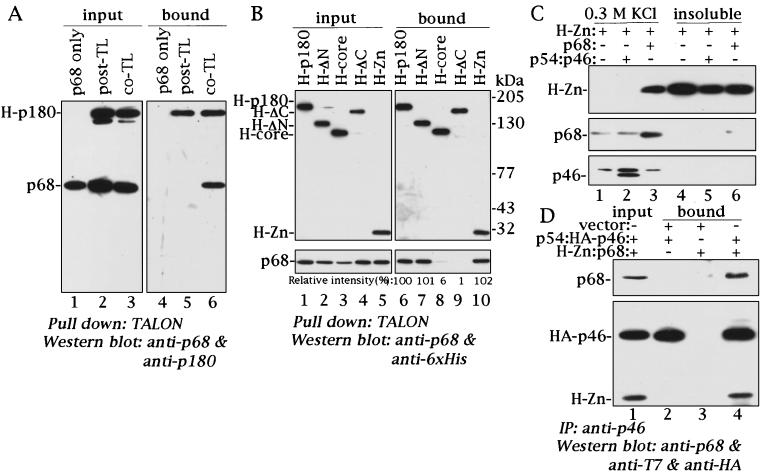FIG. 4.
Identification of the p180 domain required for the interaction with p68. (A) Extracts containing singly expressed p68 (50 μg of protein) were mixed in the presence (lanes 1 and 4) or absence (lanes 2 and 5) of singly expressed six-His-tagged p180 (50 μg of protein), incubated on ice for 1 h, pulled down with cobalt-chelating Sepharose (TALON), and then eluted with a solution containing 200 mM imidazole. Extracts containing coexpressed H-p180 and p68 (50 μg of protein) were also pulled down in parallel (lanes 3 and 6). One-third of the eluates were subjected to Western blot analysis with anti-p180 and anti-p68 antibodies (right panel). The left panel shows results with 5 μg of the input proteins. TL, translation. (B) Coprecipitation assay with p68 and six-His- and T7-tagged p180 mutants. Extracts containing coexpressed p68 and various mutants of the six-His- and T7-tagged p180 (50 μg of protein) were coprecipitated with cobalt-chelating Sepharose and eluted with 200 mM imidazole. One-third of the eluates were subjected to SDS-PAGE followed by Western blot analysis with anti-T7 tag monoclonal antibody (upper panels) or anti-p68 polyclonal antibody (lower panels). Precipitated protein levels of p68 were quantitated by densitometric scanning of the blot and are presented at the bottom as relative values compared to that of p68 coprecipitated with H-p180. (C) H-Zn can be expressed as a soluble form in the presence of p68. The carboxyl-terminal domain containing two zinc finger motifs was expressed alone (lanes 1 and 4) or in the presence of p54-p46 (lanes 2 and 5) or p68 (lanes 3 and 6). Transfected cells were lysed with a solution containing 20 mM potassium phosphate (pH 7.5), 300 mM KCl, 10% glycerol, 0.05% Triton X-100, and 0.1 mM EDTA, and insoluble materials were separated by centrifugation. Precipitates were resuspended in Laemmli sample buffer (17). Ten micrograms of protein of the soluble fraction and 10% of the corresponding insoluble fractions were subjected to SDS-PAGE followed by Western blotting with anti-six-His, anti-p68, and anti-p46 antibodies. (D) Coimmunoprecipitation assay with H-Zn–p68 and HA-tagged p46-p54. Fifty micrograms of the extracts containing coexpressed H-Zn–p68, coexpressed p54-HA-tagged p46, and vector control was mixed as shown on the top of the figure and immunoprecipitated (IP) with anti-p46 antibody. One-third of the precipitates were subjected to Western blot analysis with anti-T7, anti-HA, and anti-p68 antibodies. Lane 1 contains 6 μg of the extracts containing H-Zn–p68 and HA-tagged p46-p54 as input proteins.

